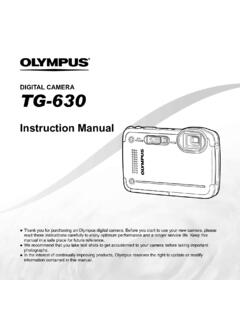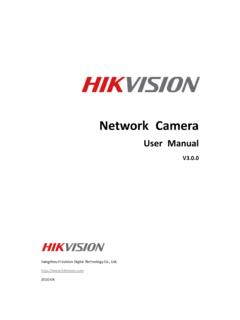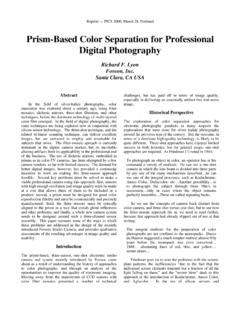Transcription of Camera Link Interface Standard Specification - ImageLabs
1 Camera LinkSpecifications of the Camera link Interface Standard for Digital Cameras and Frame GrabbersCamera link SpecificationsOctober 2000iiCamera link SpecificationsAcknowledgementsParticipat ing CompaniesThe following companies contributed to the development and definition of the Camera link Standard . Basler Cognex Coreco DALSA Data Translation Datacube EPIX Euresys Foresight Imaging Integral Technologies Matrox National Instruments PULNiX AmericaRights and TrademarksPULNiX America, Inc., as chair of this ad hoc Camera link committee, has applied for trademark protection for the term " Camera link " to secure it for the mutual benefit of industry members.
2 PULNiX will issue a perpetual royalty-free license to any industry member (including competitors) for the use of the " Camera link " trademark on the condition that it is used only in conjunction with products that are fully compliant to this Standard . PULNiX will not require licensed users of the trademark to credit PULNiX with is a trademark of the 3M link is a trademark of National is a trademark of Texas link is a trademark of Silicon link SpecificationsAbout this DocumentThe following specifications provide a framework for Camera link communication. The specifications are deliberately defined to be open, allowing Camera and frame grabber manufacturers to differentiate their products.
3 Additional recommendations may be added at a later date, which will not affect the accuracy of the information in this link SpecificationsContentsAcknowledgementsPa rticipating Companies .. iiRights and Trademarks .. iiAbout this DocumentChapter 1 Camera Technical 1-1 Channel 1-2 Technology Benefits .. 1-3 Smaller Connectors and 1-3 High Data Transmission Rates .. 1-3 Chapter 2 Camera Signal RequirementsVideo 2-1 Camera Control 2-1 Communication ..2-2 Power .. 2-2 Chapter 3 Port AssignmentsPort Definition .. 3-1 Chapter 4 Bit AssignmentsChapter 5 Camera link ConnectionsMDR 26-pin Connector.
4 5-1 Camera link Cable Pinout ..5-2 Shielding Recommendations .. 5-3 ContentsCamera link SpecificationsvAppendix AChipset CriteriaAppendix BAPI FunctionsAppendix CBit Assignments According to ConfigurationAppendix DCamera link Cabling InformationFiguresFigure link 1-2 Figure Routing for Base, Medium, and Full Configurations .. 3-2 Figure Diagram of Base, Medium, and Full Configuration .. 3-3 Figure link Cable .. 5-1 Figure of 3M Connector .. D-1 Figure Part Number Ordering Information .. D-3 TablesTable Assignments According to Configuration .. 3-1 Table link Bit 4-1 Table National Semiconductor Parts.
5 A-1 Table Assignments for Base Configuration .. C-1 Table Assignment for Medium Configuration .. C-2 Table Assignment for Full Configuration .. C-4 Table D-3 Table Boardmount Receptacle Part Numbers .. D-41-1 Camera link Specifications1 Camera LinkIntroductionCamera link is a communication Interface for vision applications. The Interface extends the base technology of Channel link to provide a Specification more useful for vision applications. For years, the scientific and industrial digital video market has lacked a Standard method of communication. Both frame grabbers and Camera manufacturers developed products with different connectors, making cable production difficult for manufacturers and very confusing for consumers.
6 A connectivity Standard between digital cameras and frame grabbers is long overdue and will become even more necessary as data rates continue to increase. Increasingly diverse cameras and advanced signal and data transmissions have made a connectivity Standard like Camera link a necessity. The Camera link Interface will reduce support time, as well as the cost of that support. The Standard cable will be able to handle the increased signal speeds, and the cable assembly will allow customers to reduce their costs through volume Technical DescriptionLow Voltage Differential Signaling (LVDS) is a high-speed, low-power general purpose Interface Standard .
7 The Standard , known as ANSI/TIA/EIA-644, was approved in March 1996. LVDS uses differential signaling, with a nominal signal swing of 350 mV differential. The low signal swing decreases rise and fall times to achieve a theoretical maximum transmission rate of Gbps into a loss-less medium. The low signal swing also means that the Standard is not dependent on a particular supply voltage. LVDS uses current-mode drivers, which limit power consumption. The differential signals are immune to 1 V common volt link Specifications1-2 Channel link National Semiconductor developed the Channel link technology as a solution for flat panel displays, based on LVDS for the physical layer.
8 The technology was then extended into a method for general purpose data transmission. Channel link consists of a driver and receiver pair. The driver accepts 28 single-ended data signals and a single-ended clock. The data is serialized 7:1, and the four data streams and a dedicated clock are driven over five LVDS pairs. The receiver accepts the four LVDS data streams and LVDS clock, and then drives the 28 bits and a clock to the board. Figure 1-1 illustrates Channel link operation. Figure 1-1. Channel link OperationReceiverReceiverReceiverReceive rReceiverDriverDriverDriverDriverDriver> GbpsData (LDVS)Data (LDVS)Data (LDVS)Data (LDVS)Clock (LDVS)TTL/CMOSData 28-bitTTL/CMOSData 28-bitClockReceiverDriver100 100 1-3 Camera link SpecificationsTechnology BenefitsSmaller Connectors and CablesChannel link s transmission method requires fewer conductors to transfer data.
9 Five pairs of wires can transmit up to 28 bits of data. These wires reduce the size of the connector, allowing smaller cameras to be Data Transmission RatesThe data transmission rates of the Channel link chipset (up to Gbits/s) support the current trend of increasing transfer link Specifications2 Camera Signal RequirementsThis section provides definitions for the signals used in the Camera link Interface . The Standard Camera link cable provides Camera control signals, serial communication, and video DataThe Channel link technology is integral to the transmission of video data. Image data and image enables are transmitted on the Channel link bus.
10 Four enable signals are defined as: FVAL Frame Valid (FVAL) is defined HIGH for valid lines. LVA L Line Valid (LVAL) is defined HIGH for valid pixels. DVAL Data Valid (DVAL) is defined HIGH when data is valid. Spare A spare has been defined for future use. All four enables must be provided by the Camera on each Channel link chip. All unused data bits must be tied to a known value by the more information on image data bit allocations, see Section 3, Bit Assignments, and Appendix C, Bit Assignments According to Control SignalsFour LVDS pairs are reserved for general-purpose Camera control.








